With EI premiums set to rise in the new year, employers and workers are calling on the federal government to step in and relieve the program of the massive debt load it has sunk into since the COVID pandemic. -19.
The program, which is funded entirely by premiums paid by workers and employers, had accumulated $25.9 billion in debt by the end of 2021, according to the Office of the Chief Actuary (OCA).
A staggering number of Canadians have been unemployed during the pandemic and eligibility rules for the program have been relaxed to make it easier to access benefits. But since then, the labor market has rebounded and temporary changes to the employment insurance program have been reversed.
“The current deficit arose because of the pandemic, and it is no employee’s fault and it is no employer’s fault,” said Jasmin Guénette, vice-president of national affairs at the Canadian Federation. of Independent Business (CFIB).
After a two-year freeze, EI premiums are set to increase by $0.05 per $100 of income in 2023, the maximum increase allowed in one year by law. However, the increase is less than what the Office of the Chief Actuary has recommended for the program to break even by 2029.
Nancy Healey, the employers’ representative on the Canadian Employment Insurance Commission, assures that “businesses (and) workers are concerned about the amount of debt that is currently in the employment insurance account”.
The EI system is overseen by a commission that regularly reviews issues and the appeals system and its funding. Commissioners make the voices of workers and businesses heard, often consult their constituents and raise their concerns with permanent civil servants.
The workers’ representative on the commission, Pierre Laliberté, reports that the federal government has not indicated whether it intends to reimburse part of the debt. “Everyone was surprised that at the budget level there was no compensation or partial compensation for the costs incurred during the pandemic. »
Asked if the federal government is expected to repay some of the debt, a spokeswoman for Jobs Minister Carla Qualtrough said in a statement: “These debts are settled on many years, the premium rates being determined on the basis of seven years of profitability forecasts. »
“With the $0.05 increase, the rate will drop to $1.63 in 2023, which remains one of the lowest rates in Canadian history,” said Jane Deeks, Director of Communications of the minister.
In 2021, the Liberals campaigned on a promise to modernize EI and pledged to expand the program to cover the self-employed and close gaps, including those highlighted by COVID-19.
Miles Corak, an economics professor at the City University of New York and a longtime EI researcher, said reform should include changes to how the program is funded.
In a memo released by the CD Howe Institute earlier this week, Corak argued for tripartite funding for the program, to which employers, workers and government contribute. In his view, workers and employers should not be burdened by unexpected economic shocks like the pandemic that cause a spike in involuntary unemployment.
“Sometimes workers are ready to work, are in the right place and have the skills needed, but the jobs just aren’t available,” Miles Corak wrote in the memo to Minister Qualtrough.
It suggests that the federal government cover increased program costs caused by unexpected economic shocks. At the same time, it should collect any surpluses accumulated during periods of low unemployment.
Although the Liberals did not give a timetable for the implementation of the reform, they should present their plan by the end of the year.
The idea of having the government contribute to the program is not new. Before the 1990s, employment insurance was financed by contributions from workers, employers and the federal government.
Unifor union president Lana Payne wants federal contributions reinstated “to alleviate the program’s accumulated deficit and support long-term program improvements for workers.”
However, Jennifer Robson, an associate professor of political management at Carleton University in Ottawa, would be surprised if there was much enthusiasm from the federal government to contribute financially. “My impression is that the current state of mind of the Ministry of Finance is much more one of budgetary restraint”.
